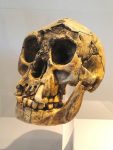
Last year, several research papers were published on the ongoing excavations and analysis of material from the island of Flores in Indonesia, where evidence of very small stature hominins was found in the cave of Liang Bua, in 2003. The initial dates dated these little people to between 50,000 and about 14,000 years ago, which would have meant that they lived side-by-side with anatomically modern humans in Indonesia, in the late Ice Age. The hominins, dubbed Homo floresiensis, after the island on which they were found, stood about 1m tall – smaller than any group of modern humans known. Their tiny size included a tiny brain – more in the range of 4 million year old Australopithecus than anything else. However, critical areas of higher order thinking in their brains were on par with modern humans.
Baffled by the seeming wealth of contradictions, these little people raised, researchers returned to the island, and the cave of Liang Bua, determined to check all of their findings in even more detail. Last year, they reported that they had in fact made some mistakes, the first time around. Very, very subtle changes in the sediments of the deposits, revealed that the Homo floresiensis bones belonged to some remnant older deposits, which had been eroded away in other parts of the cave, and replaced by much younger layers. Despite the samples for dating having been taken from close to the hominin bones, as luck would have it, they were all in the younger deposits! New dates, run on the actual sediments containing the bones, gave ages of between 190,000 to 60,000 years. Dates from close to the stone tools found with the hominins gave dates down to 50,000 years ago, but no later.

The researchers – demonstrating a high level of ethics and absolutely correct scientific procedure, published the amended stratigraphy and dates, showing how the errors had occurred. At another site, Mata Menge, they had also found some ancestral hominins – very similar in body type to the ones from Liang Bua, dated to 700,000 years ago. Palaeoanthropologists were able to find similarities linking these hominins to the early Homo erectus found on Java and dated to about 1.2 million years ago, leading researchers to suggest that Homo floresiensis was a parallel evolution to modern humans, out of early Homo erectus in Indonesia, making them a fairly distant cousin on the grand family tree.
Careful examination of the deposits has now also called in to question whether Homo floresiensis could control fire. We know that they made stone tools – of a type pretty much unchanged over more than 600,000 years, and they used these tools to help them hunt Stegodon – an Ice Age dwarf elephant, which was as small as 1.5m at the shoulder. However, researchers now think that evidence of controlled fire is only in layers associated with modern humans. It is this cross-over between Homo floresiensis and modern humans, arriving about 60,000 – 50,000 years ago, that is a focus of current research – including that of teams working there now. At the moment, it looks as if Homo floresiensis disappears at about the same time that modern humans arrive, which sadly, is a not totally unlikely pattern.

What does this have to do with Australia? Well, it’s always interesting to get information about our immediate neighbours and their history (and prehistory). But beyond that – we know that the ancestors of Aboriginal people (modern humans) were in Australia by about 60,000 – 50,000 years ago, so understanding how they arrived is part of understanding our own story. For more case studies on interesting topics in archaeology and palaeontology see our Archaeology Textbook resources for Year 11 students.

The material is much more interesting. When I discussed a topic later in the term, I found that the students…
Laura Davidson, Teacher